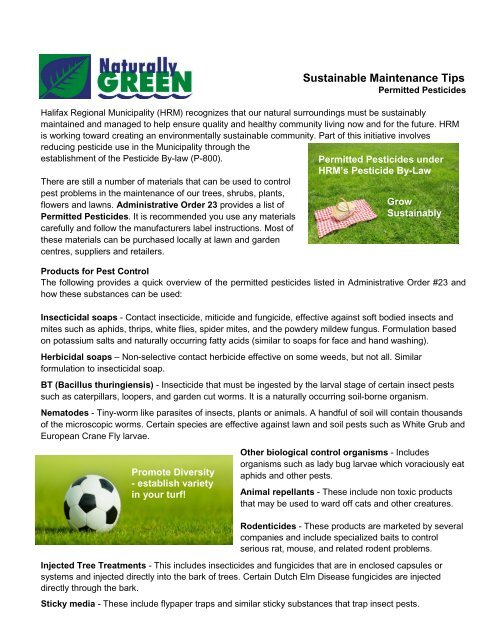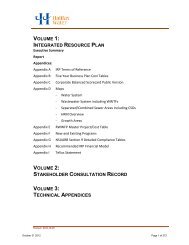Permitted Pesticides - Halifax Regional Municipality
Permitted Pesticides - Halifax Regional Municipality
Permitted Pesticides - Halifax Regional Municipality
You also want an ePaper? Increase the reach of your titles
YUMPU automatically turns print PDFs into web optimized ePapers that Google loves.
Sustainable Maintenance Tips<br />
<strong>Permitted</strong> <strong>Pesticides</strong><br />
<strong>Halifax</strong> <strong>Regional</strong> <strong>Municipality</strong> (HRM) recognizes that our natural surroundings must be sustainably<br />
maintained and managed to help ensure quality and healthy community living now and for the future. HRM<br />
is working toward creating an environmentally sustainable community. Part of this initiative involves<br />
reducing pesticide use in the <strong>Municipality</strong> through the<br />
establishment of the Pesticide By-law (P-800).<br />
There are still a number of materials that can be used to control<br />
pest problems in the maintenance of our trees, shrubs, plants,<br />
flowers and lawns. Administrative Order 23 provides a list of<br />
<strong>Permitted</strong> <strong>Pesticides</strong>. It is recommended you use any materials<br />
carefully and follow the manufacturers label instructions. Most of<br />
these materials can be purchased locally at lawn and garden<br />
centres, suppliers and retailers.<br />
<strong>Permitted</strong> <strong>Pesticides</strong> under<br />
HRM’s Pesticide By-Law<br />
Grow<br />
Sustainably<br />
Products for Pest Control<br />
The following provides a quick overview of the permitted pesticides listed in Administrative Order #23 and<br />
how these substances can be used:<br />
Insecticidal soaps - Contact insecticide, miticide and fungicide, effective against soft bodied insects and<br />
mites such as aphids, thrips, white flies, spider mites, and the powdery mildew fungus. Formulation based<br />
on potassium salts and naturally occurring fatty acids (similar to soaps for face and hand washing).<br />
Herbicidal soaps – Non-selective contact herbicide effective on some weeds, but not all. Similar<br />
formulation to insecticidal soap.<br />
BT (Bacillus thuringiensis) - Insecticide that must be ingested by the larval stage of certain insect pests<br />
such as caterpillars, loopers, and garden cut worms. It is a naturally occurring soil-borne organism.<br />
Nematodes - Tiny-worm like parasites of insects, plants or animals. A handful of soil will contain thousands<br />
of the microscopic worms. Certain species are effective against lawn and soil pests such as White Grub and<br />
European Crane Fly larvae.<br />
Promote Diversity<br />
- establish variety<br />
in your turf!<br />
Other biological control organisms - Includes<br />
organisms such as lady bug larvae which voraciously eat<br />
aphids and other pests.<br />
Animal repellants - These include non toxic products<br />
that may be used to ward off cats and other creatures.<br />
Rodenticides - These products are marketed by several<br />
companies and include specialized baits to control<br />
serious rat, mouse, and related rodent problems.<br />
Injected Tree Treatments - This includes insecticides and fungicides that are in enclosed capsules or<br />
systems and injected directly into the bark of trees. Certain Dutch Elm Disease fungicides are injected<br />
directly through the bark.<br />
Sticky media - These include flypaper traps and similar sticky substances that trap insect pests.
Borax - Boric acid powder is used to kill roaches, ants, fleas and silverfish. It is an odourless and nonstaining<br />
powder.<br />
Dormant and Horticultural Oils - These are often applied, during the off season, on plants, shrubs and<br />
small trees to control overwintering pests such as the scale insect and other insect egg masses by<br />
suffocating the pests. These are highly refined oils that are mixed with water for application.<br />
Bordeaux mixture and other sulphur compounds - These materials are used on certain fungus problems<br />
on plants. It is a fungicide consisting of cupric sulphate and lime in water.<br />
Lime sulphur - Sulphur is used as both a fungicide, miticide and insecticide. It helps control mites, certain<br />
insect eggs, and fungi such as powdery mildew, rust and brown spot. Lime sulphur is a mixture of lime and<br />
sulphur.<br />
Ferric phosphate - This is a molluscicide used to control slugs and snails. It is an iron (ferric) and<br />
phosphate compound.<br />
Pruning paint - Decorative treatments to coat tree wounds and pruning cuts. However, the application of<br />
paint on pruning cuts may actually hinder callous formation (natural sealing of the cut or wound).<br />
Pheromone traps - Traps used to lure and then trap insect pests. They often contain synthetic and/ or<br />
natural chemicals resembling insect sex attractants placed inside the traps.<br />
Pyrethrum (or pyrethrin) - These are contact insecticides used to control a number of different insect<br />
pests. Pyrethrins are natural insecticides produced by certain species of the chrysanthemum plant.<br />
Diatomaceous earth - This is used as a contact (scarifying) insecticide. It is a naturally occurring<br />
substance comprised of the fossilized remains of diatoms. Diatoms are microscopic sized hard-shelled<br />
creatures found in both marine and fresh waters. Diatoms are covered in sharp spines that make them<br />
dangerous to exoskeletal insects, but not to animals with internal skeletons.<br />
Acetic acid - is a clear, colourless liquid with a sharp vinegar smell. Typically vinegar is about 4-8% acetic<br />
acid. Acetic acid is marketed under various trade names as a non-selective weed and grass killer.<br />
Corn Gluten Meal- This is used as a non selective pre-emergent weed seed inhibitor, especially for<br />
dandelions and smooth crabgrass in lawns. Corn gluten meal can also have significant nitrogen content and<br />
may be applied as an organic slow release fertilizer. Corn gluten meal is a by-product of the wet milling<br />
process of corn for starch.<br />
Iron HEDTA (FeHEDTA) - is a deep red, odourless liquid compound, used on lawns to control weeds,<br />
algae and moss.<br />
With a bit of planning and proper lawn management, the need for chemical pesticides can be greatly<br />
reduced, if not eliminated. Easing our dependency on chemical lawn additives is better for both human<br />
and environmental health and is a necessary step towards the attainable goal of sustainable gardening<br />
and landscape maintenance.<br />
For more information on the Pesticide By-Law (P-800) including signage requirements, which products can still be<br />
used, alternatives to pesticides, sustainable maintenance practices, or to access details on our public awareness<br />
sessions, visit one of the HRM Customer Service Centres or log on to our website at www.halifax.ca. You can<br />
also call our representatives at 490-4000 or email us at Pestbylaw@halifax.ca.

















